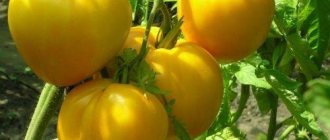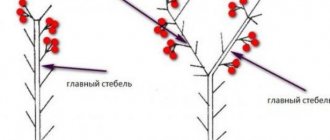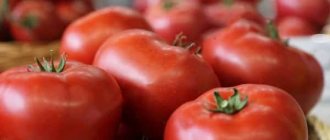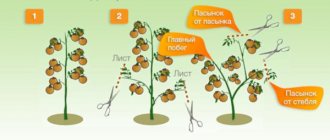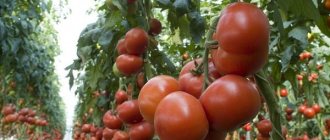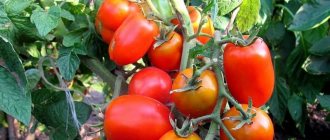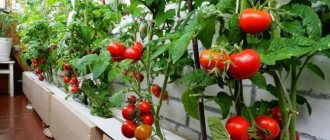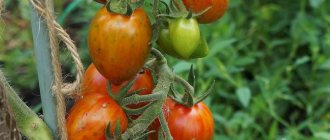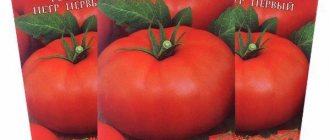Characteristics of the Russian tomato Gavrosh and features of growing the variety
Tomato Gavroche is recommended by breeders for cultivation in open fields; the characteristics and description of the variety were included in the State Register of Russia in 1997.
Some information about the plant
Characteristics and description of tomato:
- The fruits appear 82-84 days after planting the seedlings in the ground. Early ripening ends with friendly fruiting, and this allows you to quickly harvest the crop.
- The height of the bush reaches 0.45-0.5 m, so to grow a tomato there is no need to tie its branches to trellises or supports.
- The inflorescence of Gavroche is of an intermediate type and simple. The first ovary appears above the 6th or 7th leaf, and all the rest develop through 1-2 leaves.
- The stalk on tomatoes of the described type has an articulation.
- The fruits are spherical in shape and colored red. The surface of such a ball is smooth.
- The berries weigh from 40 to 50 g. There are 2 or 3 seed nests inside the pulp.
Reviews from farmers involved in growing this variety show that its yield is 1500-1800 g of fruit from each bush. Gardeners note that Gavroche is relatively resistant to the tobacco mosaic virus. Productivity decreases sharply if the gardener does not carry out preventive work to prevent cladosporiosis.
You can increase productivity by following all the recommendations of experts. Although the plant is intended for cultivation in open soil, some gardeners have grown it in greenhouses. At the same time, productivity increased by 20-30%.
Open ground in the southern regions of Russia is better suited for this variety. In the vast expanses of the middle zone, the Far North and Siberia, it is recommended to plant seedlings in greenhouses with good heating.
Growing tomatoes in your own backyard
Seeds for seedlings are sown in boxes filled with soil for tomatoes. The seed fund is buried in the soil to a depth of 15-20 mm. The sprouts that appear after 5-8 days should be fed with organic fertilizers (manure). After the seedlings develop 1-2 leaves, they are plucked.
After 45 days, the sprouts are transferred to permanent soil. Before this, the plants are hardened off for a week. Before planting the bushes, the soil is loosened, humus and nitrogen fertilizers are added to it. Due to its small growth, the tomato does not need to be tied to supports, but the removal of excess shoots is required. The planting format is 0.5x0.5 m.
Watering is carried out early in the morning or after sunset. For this purpose, settled warm water is used. The frequency of this procedure is 1-2 times a week.
To eliminate tomato infection by any disease, it is recommended to weed the beds at least 1-2 times a week. Loosening of the soil is carried out every 10 days.
Timely implementation of all procedures provides the bushes with the flow of necessary oxygen to the root system, serves as a barrier to the occurrence of tomato diseases, and helps get rid of parasites on tomato roots.
Plants are fertilized 3 times per season. First, nitrogen and organic fertilizers are used, and after flowering begins, the bushes are fed with potassium mixtures. When the first fruits appear, the gardener must feed the tomato bushes with complex fertilizers.
If symptoms of fungal or bacterial infection appear on the plants, it is necessary to destroy the diseased bushes before the disease spreads to tomatoes of other varieties. Then the leaves and stems of healthy specimens are treated with medications.
When garden pests appear on the bushes, it is recommended to destroy them using folk remedies or chemical poisons. Elimination of root parasites and slugs is carried out by adding ash flour to the soil under the bushes.
Varieties for open ground
A huge number of species with excellent yields are intended for growing vegetables in the open air. Low-growing bushes with large fruits are one of the advantages of tomatoes for the soil. Such heat-loving plants are easier to care for and do not require complex agricultural practices.
According to ripening period
Tomatoes, like other vegetable crops, are characterized by different ripening periods, from early to late.
The ripening time, color and shape of tomatoes depends on the variety.
Usually early-ripening vegetables with not large fruits and not a large harvest, but with a quick, friendly yield of ripe tomatoes. Mid-season ones also have medium sizes. Late ones are usually difficult to care for, but it is among them that you can find champions in weight, but there are not many such beauties on the bush.
By growing region
Every year, breeders create new species with high quality indicators. In stores you can buy specialized varieties of tomatoes designed for growing in certain climatic conditions. Classification by regions of Russia:
- for the Moscow region: Champion, Sweet Bunch, Honey, Pink Elephant, Fireworks, Bull's forehead;
- for the southern regions: Torch, Novice, Titan, Winner, Bison, Ermak, Gift, Mikado;
- for the middle zone: Bull's Heart, Black Prince, Uzbek (Yusupov), Moskvichka, Snowdrop, Big Brother, Spasskaya Tower;
- for Siberia: Siberian heavyweight, Ultra early ripening, Sanka, Abakan pink;
- for the Urals: Coin, Bull's Heart, Button, Countryman, Yellow Buyan, Bullfinch, Demidov;
- for the far north: Snowy Tale, Ballerina, Ladyfingers, Berdsky Large, Countryman, Oak, Gina.
An unpredictable, cold or, conversely, excessively warm climate is not a reason to refuse to grow tomatoes in open ground. Thanks to selection, varieties have been developed that grow and develop well in any terrain.
According to disease resistance
To obtain a rich harvest, you need to choose tomato varieties not only with the appropriate characteristics. It is necessary that this criterion be supplemented by such an indicator as disease resistance.
Late blight, root rot, tobacco mosaic, cladosporiosis are diseases that most often affect plantings of heat-loving crops.
A catalog of tomatoes that can withstand the onslaught of various diseases:
- Blitz;
- Koenigsberg;
- Geisha;
- Betta,
- Anyuta;
- Bohemia;
- Chio-chio-san;
- Tatiana;
- Puzata hut;
- Lights of Moscow;
- Yablonka Russia;
- Crimson giant.
Unfortunately, there are no varieties that are 100% resistant to infections. But there are hybrids that produce a harvest until the active phase of many fungal diseases and infections begins.
What are standard tomatoes
Clear advantages of growing “tomatoes for the lazy”:
- Close location of roots to the surface. Growing is simplified because the soil absorbs a sufficient amount of moisture and nutrients.
- Excellent adaptation to climatic conditions. The tomato bush (determinant) is resistant to cold in the middle zone and drought.
- Fast growth. Standard tomatoes quickly form ovaries, which allows the fruits to ripen in a short period of time.
- Cancellation of stepsoning. A standard tomato plant is, first of all, an opportunity to get rid of the need to remove excess shoots.
- Excellent adaptation to the ground. A low-growing tomato easily tolerates replanting without any loss in yield and presentation.
- Long-term storage of vegetables. Standard varieties of tomatoes for open ground or in greenhouse mode retain their taste for a long time.
Such characteristics explain the popularity of this culture.
Advantages of standard tomatoes
This is a special variety of tomatoes, which is characterized by low growth and modest dimensions. Since the bushes do not grow tall, they are easier to care for—there is no need to tie up the stems for fear that they will break.
Since these varieties do not require special care, standard tomatoes are liked by many gardeners. There are dozens of different varieties that satisfy the needs of both amateur gardeners and professional farmers.
These varieties can be recognized by a number of characteristic features:
- their bushes are small and neat;
- tomatoes do not require pinching;
- maximum height – 0.6 m;
- tomatoes bear fruit well even when planted densely; their root system does not require much space;
- They are grown either in open ground or in greenhouses.
Variety Eagle Heart
The high-yielding variety Eagle Heart (Russia) was pampered with a wall of fruits. The bush is tall, the fruits are pink, heart-shaped, tasty, sweet, dense. By the way, ripe fruits remain on the bush for a long time, remain attractive, retain their presentation, and do not lose their taste and nutritional qualities. Drought- and frost-resistant, resistant to late blight and other common tomato diseases.
The guests who came to see our garden were all, without exception, amazed by the luxurious appearance of the mid-early fruits. And having tried them, they were indescribably delighted and “fell ill” with this variety forever.
Source: sad-dacha-ogorod.com
The best large-fruited tomatoes: the largest varieties of tomatoes and their photos
Previously, those varieties whose fruit weight was over 120 g were classified as large-fruited tomatoes. Now tomatoes weighing more than 200-250 g are classified as large-fruited.
As can be seen in the photo, the fruits of large varieties of tomatoes are usually flat-round or flat, multi-chambered, fleshy, red or pink, tall and late-ripening:
But among this group there are earlier and shorter ones. The earliest large-fruited tomato is Jane, which combines early ripening, short stature and large-fruited. And already well-known tall hybrids:
F1 Krasnobay, F1 Grandmother's Gift,
F1 Russian size, F1 Matryoshka allow you to get fruits from 200 to 600 g, and with good shaping and care, even more.
With such a huge variety of varieties of good large-fruited tomatoes, the choice is yours.
Large tomatoes can be obtained by rationing the inflorescences, that is, pinching off the brushes and leaving 2-3 fruits in them. The best large varieties and hybrids are suitable for these purposes:
tomatoes, like F1 Krasnobay, F1 Grandma's Gift,
Russian is delicious, Jane,
F1 Funtik, F1 Bityug,
F1 Rosemary, Pelageya,
Akulina, Gorlinka,
Blush, Chubby, F1 Rosebeef.
The most delicious large-fruited tomato varieties are shown in these photos:
Diseases and pests
Being a hybrid, the Dobry f1 tomato has increased resistance to many diseases - fusarium, tobacco mosaic virus. However, like all tomatoes, it is susceptible to other diseases, including late blight. Fitosporin or treatment with copper-containing preparations are used as a preventative measure to combat it.
To reduce the likelihood of infections in the greenhouse, it is recommended to carry out the following treatment every autumn:
- Clear the greenhouse area of plant debris.
- Disinfect the walls, frame of the greenhouse, and all auxiliary equipment with a solution of laundry soap.
- Treat the soil in the greenhouse with biological products - “Fitosporin”, “Shine -1” or chemicals - potassium permarganate, Bordeaux mixture.
- Treat the soil with lime and dolomite flour.
- Sow herbs – mustard, phacelia.
Carrying out these measures in the fall will reduce the number of harmful bacteria that actively reproduce in favorable conditions. Tilling the soil will also help in the fight against pest larvae inhabiting the greenhouse.
Tomatoes are affected by the following pests: slugs, spider mites, and Colorado potato beetles. To combat them when they appear en masse, there are many chemicals, but usually gardeners prefer folk remedies - infusions of dandelion, garlic, hot pepper.
Are there tomatoes that are never affected by late blight?
Many farmers are trying to solve the problem with late blight by planting early-ripening crops.
Such varieties manage to produce a harvest before the outbreak of the epidemic. The infection is known to develop in hot, humid weather. Usually this period covers the end of July - August. Early ripening varieties have already finished bearing fruit by this time. Thanks to the labor-intensive work of breeders, tomato varieties have emerged that are resistant to late blight and other diseases. But it is worth noting that there is no 100% guarantee that this variety will not get late blight. The plant is simply more resistant to fungus.
Advantages and disadvantages
Every plant has its pros and cons. Pervoklaska tomatoes are no exception, about which there are many reviews and photos, more positive than negative.
Advantages:
- bright, sweet, expressive taste;
- early maturation;
- uniform yield of the harvest - fruits on several clusters ripen almost simultaneously;
- high productivity;
- good keeping quality;
- excellent transportability;
- long fruiting period.
But besides the wonderful advantages, the tomato also has disadvantages:
- determinacy can limit the growth of the bush, additional brushes will stop forming, which will limit the yield;
- demands for more enhanced mineral nutrition;
- susceptibility to diseases, in particular late blight.
Limiting the growth of the bush, of course, limits the number of fruits, but the high yield of the variety, smooth ripening and excellent taste of tomatoes still delight those who like to eat aromatic pink sweet tomatoes.
Tomato Gavrosh: characteristics and description of the variety
Russian Gavroche tomatoes have been known to connoisseurs and gardening enthusiasts since the late 90s. The variety owes its appearance to scientist-breeders of the famous agro. Cute plants with decorative, tasty small fruits are in great demand and now do not need advertising. However, beginners who want to quickly grow high-quality sweet fruits need to learn more about the characteristics of the variety.
Tomato Gavrosh: characteristics and description of the variety
Initially, the variety was created for cultivation in open ground in conditions with a mild climate, without sudden temperature changes, so in the northern and northwestern regions it is planted in various types of greenhouses.
The variety is ultra early ripening. From the moment the seedlings sprout to the first fruits, only 80-85 days will pass. Thus, having sowed the seeds in April, you can already taste the harvest at the end of June.
The fruits are small, bright, round cherry tomatoes when ripe reach a weight of no more than 50 grams. Very sweet and fleshy, with a small amount of seeds. The skin is elastic and thin.
Several pieces ripen in a bunch (no more than six). Typically, each bush has six bunches of fruit, ideal for fresh consumption and canning. A glass jar filled with neat toy fruits will perfectly complement the menu during the cold season.
Note! The semi-determinate tomato grows only half a meter in height and, according to reviews from gardeners, does not need staking. Productivity - up to 1.5 kg per bush
This is a good harvest for such compact plants. Moreover, they ripen early, the bush gives all its strength and within two weeks the fruits ripen completely. After harvesting, the plants are removed from the greenhouse or garden bed
Productivity - up to 1.5 kg per bush. This is a good harvest for such compact plants. Moreover, they ripen early, the bush gives all its strength and within two weeks the fruits ripen completely. After harvesting, the plants are removed from the greenhouse or garden bed.
This variety provides not only for cultivation in industrial quantities, but also for cultivation in a limited space. A solid harvest can be harvested even on the balcony!
Note! The Gavroche tomato variety hardly gets sick. The variety is resistant to common tobacco mosaic, but is susceptible to cladosporiosis - brown spot - affecting both leaves and fruits
However, preventive measures will protect you from harm. To provide plants with immunity, you need:
The variety is resistant to the common tobacco mosaic, but is susceptible to cladosporiosis - brown spot - which affects both leaves and fruits. However, preventive measures will protect you from harm. To provide plants with immunity, you need:
- observe crop rotation;
- plant no more than 4-5 plants per 1 square meter (dense plantings prevent ventilation);
- spray the plant with Bordeaux mixture;
- do not over-moisten the soil.
And, of course, “laying the foundation” occurs when:
- seed selection;
- their disinfection and hardening;
- preparing the soil for sowing - this variety tolerates loose and light soil best. Loam is too much of a challenge for him.
When planting, the seeds should be buried 1-1.5 cm, and after a week they should be fertilized with diluted mullein.
Picking is done after two leaves appear.
Gavroche tomato seedlings, reaching 30 cm in height, are planted in the garden bed. It should not be overgrown in pots - it stretches out, becomes thinner, and becomes frail, which will immediately affect the yield.
Attention! Before planting in a greenhouse or garden bed, it is important not to forget to harden the seedlings in the fresh air for a week, gradually increasing the time spent there. Humus and nitrogen fertilizer must be added to each hole.
Humus and nitrogen fertilizer must be added to each hole.
Plants require moderate watering - only when the top layer of soil dries out, in the evening or early in the morning. The water should not be cold.
Despite the fact that the bushes are small, pinching should still be carried out, especially on the lower shoots.
Regular weeding of the beds will eliminate possible diseases. A couple of times a week you need to remove all small weeds that appear.
During the flowering period, fertilize the bushes with potassium fertilizer (potassium sulfate or ash). Apply the third fertilizing with complex fertilizer during the period of fruit formation.
A description of the Gavroche tomato variety will help lovers of this vegetable decide on the choice of seeds for the next season.
History of the variety's creation
This ultra-early tomato variety was created by Russian breeders from the agrotechnical company Gavrish at the end of the last century.
Tomato Gavroche photo
This company is new to the seed and breeding market, it was created in 1993, but its seeds and new varieties of vegetables, bred by the specialists of this company, are in demand not only among Russian farmers, but also abroad.
The Gavroche tomato was included in the State Register in 1997. These tomatoes are recommended to be grown in open ground beds on small farms and in garden plots.
Different groups of tomatoes
Tomato fruits of all varieties and hybrids can be divided into several different groups based on weight. These are tomatoes with a fruit weight of 15-30 g - cherry tomatoes. They are closest to the ancient tomatoes, when the presence of a small fruit contributed to survival and its spread. In modern cherry tomatoes, the fruits in the inflorescence are equal in weight, resistant to cracking and have at least 12-14 fruits in the cluster. Cherry tomatoes have a completely unique taste. Typical representatives of cherry tomatoes: Red cherry, Yellow cherry, Winter cherry, Cherry cocktail.
However, there has always been a need for larger and better fruits. The following group has appeared: tomatoes weighing from 30-60 g - cocktail tomatoes. They are characterized by simple long or complex branched inflorescences and fruits of various shapes and colors. These are tomatoes:
Galapagos, Patron, Cio-chio-san.
The next group of tomatoes is racemose with a fruit weight of about 100 g. The fruits in the inflorescence are equal in weight, they are characterized by simultaneous ripening (F1 Intuition).
Regular tomatoes are the most common group with a fruit weight of 120-140 g, a simple inflorescence, high quality fruit, and good storage characteristics:
F1 Evpator, F1 Pharaoh,
F1 Alcazar, F1 Alhambra.
Tomatoes suitable for growing in open ground by direct sowing (seedless method):
Volgogradsky 323, Gifts of the Volga region,
Betta, Alaska,
Early 83, Siberian early ripening,
Newbie, Gavroche,
Parodist, Moment, Pygmy, etc.
There are tomatoes that are easy to grow and do not require pinching. For those who want to get an early, healthy harvest of medium-sized tomatoes without installing protected structures, the following early-ripening varieties and hybrids are suitable:
Agatha, Alaska
Betta, Biathlon,
Bonsai, F1 Blitz, Boni-M. The plants are low-growing, compact, and do not require pinching. Hybrids begin to bear fruit very early, so they can be grown without seedlings - by direct sowing in the ground.
A little about the color of tomatoes and their usefulness. Red and orange fruits and other more unconventional colors are also useful. All brightly colored tomatoes contain carotene and lycopene. Pink-fruited tomatoes contain no less lycopene than red-fruited ones. Lycopene is a powerful biologically active substance with anticancer activity and protective properties against retinal degeneration. Carotene, provitamin A, found in tomato fruits, is a powerful antioxidant involved in many vital processes in the human body.
Which tomatoes are the sweetest? As you know, there is no arguing about tastes, but, of course, cherry-shaped ones are rightfully considered the sweetest. As the size of the fetus increases, so does the size of the cells that make up the fetal tissue. Their water content increases, and as a result, the amount of sugars and acids may decrease. In the fruits of cherry tomatoes, the water content is less, the amount of dry matter is greater, hence the taste is brighter and richer.
Now regarding the suitability of tomatoes for whole-fruit canning. Depending on the tastes of the household, plum-shaped, banana-shaped, pepper-shaped, rounded tomatoes with strong skin, bright color and a small mass that freely fits into the neck of the container are chosen for whole-fruit canning. The best tomatoes are:
De Barao (pink, yellow, red, black - the most beautiful mixture in a jar),
Khokhloma, Chukhloma,
Capia rosea, Banana red,
Baskak, Rocker,
Hyperbole, F1 Kineshma.
Tomatoes differ from each other not only in the type of growth, but also in shape, weight and color.
Intermediate type of inflorescence - 1-2 times branched (cherry-shaped, cocktail), the first inflorescence in some ordinary tomatoes); a complex inflorescence - branched many times (cocktail tomatoes) and a very complex inflorescence - resembling a panicle in appearance.
Landing
As with all tomatoes (with the exception of rare varieties), before planting them in open ground, it is necessary to grow seedlings at home.
The approximate time for planting Lotus seeds is about a month and a half before transplanting the seedlings into the garden. Considering that the ripening period for Lotus fruits from the moment the first shoots appear is about 100 days, and the first ripe fruits can be obtained already at the end of June (or beginning of July), it is necessary to sow the seeds somewhere in mid-March.
Lotus tomato seeds are planted in fertile soil in trays or pots, previously washed and pickled with a weak manganese solution.
Before planting, both purchased and own Lotus seeds must be germinated in a damp cloth in a warm room, in a place most illuminated by daylight. As a rule, these are window sills.
It takes about a week for the first sprouts to appear, after which the sprouted seeds are planted in trays (pots) for seedlings, sprout upwards, in depressions in the soil (holes or furrows), about 1.5 centimeters deep, and sprinkled with soil, lightly moistening it from above with a spray bottle. . After this, the containers with future Lotus seedlings are covered with a transparent film for five days and left in the sunniest places of the room until the first shoots. Then the film is removed and care for the seedlings begins.
Growing tomato seedlings Lotus
The growth rate of seedlings largely depends on the number of sunny days at this time, but if you do not care for them properly, they may die. To help the seedlings get stronger before their future planting in open ground, you need to perform the following simple operations:
- ensure that the temperature in the room with seedlings does not fall below +20 degrees;
- water the seedlings with warm water (preferably non-chlorinated) as a dry soil crust forms;
- simultaneously with watering, once every two weeks, apply special fertilizer for tomatoes;
- about two weeks before planting seedlings in open ground, they must be regularly exposed to the open air for gradual adaptation to natural growth conditions (the temperature outside should not be lower than 14 degrees).
Planting Lotus tomato seedlings in the ground
Lotus tomato seedlings are planted in open ground in the first half of May.
It is recommended to place no more than 4-5 tomato seedlings per 1 square meter of bed. Replant very carefully, with as much soil as possible from the tray (pot), into a previously prepared depression, the volume corresponding to the root system of the seedling. It is advisable to add a handful of compost and a little wood ash under its root. This will accelerate its growth, facilitate the process of adaptation to natural conditions, and also help overcome the traditional pain of seedlings during transplantation.
Grandma's gift
The “Grandma’s Gift” tomato is presented in the “Russian Taste” series. A sales leader that has successfully proven itself in various regions of Russia. Gardeners note the advantages of the variety:
- great taste;
- good performance when harvesting tomatoes (5-5.5 kg from one bush);
- disease resistance.
It must be taken into account that this tomato has a medium-late ripening period, therefore, in the conditions of the Urals or the North-West, it is cultivated only in shelters. On ridges in a short summer, all the tomatoes may not have time to form, and yields will be lower.
The bushes are very powerful, strong, with thick stems. Height – 1.5-1.7 meters. The foliage is large, very rich green. The fruits are formed in clusters; in total, up to 9 inflorescences are formed on the bush.
The tomatoes are weighty, regular round, slightly flattened on top, about 200-250 grams each. When fully ripe, the skin and pulp are red, with a pearlescent tint. The skin is dense, thin, covering the fleshy juicy pulp. The variety is superior in taste to many other tomatoes, and this is not an advertisement, but reviews from gardeners.
The main application is fresh salads, slicing. The variety is not particularly suitable for preparing preparations, but if necessary, you can preserve tomatoes in slices.
"Raspberry Dream"
When choosing the sweetest varieties of tomatoes, you may not yet be able to find the seeds of this tomato, but do not ignore it. Very soon this variety will be popular among lovers of tomato masterpieces.
The variety was entered into the register in 2022. The originators of “Raspberry Dream” are LLC NPO “Garden and Vegetable Garden”, Chelyabinsk region. The variety was included in the register for cultivation in all regions of the country in the first year of testing, and this says a lot.
Early fruiting of tasty tomatoes for salad consumption would seem to be nothing new, but a pink tomato with such a harvest has not yet been experienced by our vegetable growers.
The tomato is flat-round in shape and has a very beautiful, rich pink color. The density is average, and the ribs covering the fruit are light on some tomatoes and absent on others.
The weight of a tomato does not fall below 380 g, but 450 is also normal. At the same time, the harvest can be harvested up to 15 kg per square meter, which is a lot for a low-growing tomato.
Advantages:
- taste;
- productivity;
- large-fruited.
Growing
For beginning gardeners, there is simply no better variety of tomatoes. The bushes develop well and bear fruit in dense or loose soil. At the same time, they can be planted densely. When planting six bushes on one square meter, the harvest is very generous. With proper and very easy care, you will get at least 16 kg of wonderful tomatoes from one m2.
It is noteworthy that in the southern regions Aurora seeds can be planted directly into the soil. In this case, the fruits will ripen a week earlier. The main thing is that the warm weather lasts at least 4 months.
In central Russia and further north, seedlings have to be grown.
Plant the seedlings in the beds after the threat of May frosts has passed. In Central Russia and the Moscow region, this is best done with the onset of calendar summer. Plant the bushes every 40 cm from each other, and the distance between the rows should be at least 60 cm. As you can see, the planting will be very dense. However, there is no need to be afraid of this. In this case, the plants will have enough light and fresh air. By July, be ready to harvest.
The Aurora-F1 hybrid is not capricious. Gardeners like this feature. Water the bushes only as needed, when the top layer of soil dries to a depth of 2-3 cm. Water for irrigation should be clean and its temperature should not be lower than 15 degrees.
Due to the density of planting, weeds do not grow actively in the area under these tomatoes. Usually you have to weed the beds no more than twice a season. The first time this is done is when the stems of neighboring bushes begin to touch.
The variety is unpretentious to feeding. Experienced gardeners fertilize the soil under these tomatoes only twice a summer. To do this, they use complex mineral fertilizers, which they apply under the bush along with watering. The first time this is done when the seedlings have begun to actively grow, and the second time when fruit set has begun.
Caring for early ripening tomatoes
We’ve sorted out the most successful early-ripening varieties and hybrids of tomatoes, and now here are some universal tips for growing them.
It is advisable to prepare a bed for these tomatoes in the spring, and not in the fall, so that the weeds do not have time to sprout before the tomatoes. The bed is placed in a well-lit place protected from the wind. The soil is dug up, while applying fertilizers:
- half a bucket of rotted compost or humus;
- 2 tbsp. wood ash for every sq.m.
There is no need to soak the seeds before sowing. Instead, they moisten the soil well and plant dry seeds to a depth of 1 cm. A temporary film cover is installed over the beds to retain moisture in the soil and not disturb the seeds once again by watering. Shoots should appear approximately 1-1.5 weeks after sowing.
If you grow early-ripening tomatoes through seedlings, there is no need to harden off the seedlings. As a rule, they are planted in the ground in early June in the phase of 5-6 true leaves.
Have fun growing these hardy, hardy tomatoes!
Description and characteristics of the variety
The explanation for such a romantic name for tomato lies in its description. This is an early tomato, and, as you know, Aurora, according to ancient mythology, symbolizes the dawn.
The hybrid begins to bear fruit already 90-91 days after the first shoots appear. Therefore, it is included in the group of ultra-early tomatoes, which are usually of interest to gardeners from Siberia, the Urals, and regions of the North-West.
Aurora is a determinate tomato, the bush grows to about 60-65 cm, and when planted in a greenhouse it can be higher (up to a meter). The leaves are loose, dark green, medium in size. The first cluster of fruits is usually tied above the 7th leaf, subsequent clusters - through two leaves.
The fruits are beautiful, smooth, bright red in color. The surface is smooth, glossy, with slight ribbing visible closer to the stalk. If a tomato is grown in open-air garden beds, the weight of the tomatoes reaches 100-110 grams; in greenhouses, the fruits grow larger, up to 130-140 grams. The skin is dense, the flesh is juicy, tasty, with a very pronounced tomato aroma.
Aurora is usually used for salads, sauces and dressings. The hybrid is also suitable for canning and assorted dishes. Quite a light tomato, transportable.
Advantages and disadvantages of the Aurora hybrid
The Aurora F1 tomato, according to the State Register of the Russian Federation, is recommended for cultivation in all regions. In the south, in the middle zone, it grows well in open ground; in regions with a more severe climate, it is grown in greenhouses. This early hybrid gives good results when planted in polycarbonate greenhouses, in which the fruits ripen faster.
Advantages:
- productivity (even in an unfavorable year, a tomato will delight you with very good results);
- early ripening of tomatoes;
- excellent taste (not every early-ripening tomato can boast of a sweet taste, but Aurora has just that);
- unpretentiousness;
- high commercial quality of fruits;
- possibility of universal use;
- friendly return of fruits from the bushes;
- resistance to various diseases.
In addition to the fact that the main batch of the crop ripens early, and late blight does not have time to “take over” the tomato, Aurora is also resistant to infections. The small size of the bushes allows you to grow tomatoes in compacted plantings, up to 6 bushes per square meter. Moreover, from such an area, with proper agricultural technology, you can harvest up to 16 kg of tomatoes.
Another “plus” is that Aurora is grown in small quantities, since the plant itself is quite compact.
The hybrid has only one “minus” (at least in the reviews of gardeners there were no other opinions) - you cannot take seeds from it for subsequent plantings. If you want to grow Aurora, you will have to spend money on seeds every year.
Which varieties get sick less often?
They are the ones least likely to be affected by late blight.
Determinate tomatoes have a number of features. Their fruiting period is long. The shrub grows to the fourth ovary and then stops growing. Productivity is high. Ripening dates are usually early. The bush has no side shoots. But if they exist, their number is very small. The size of the fruits is not the same. There are also indeterminate species. They grow tall - up to 2 meters. Ripening dates are later. The size of the fruits is the same. Their shape is perfect. However, such varieties are often affected by late blight. Therefore, when growing in a greenhouse, it is necessary to constantly monitor the humidity level and temperature.
This is interesting: Giant lemon tomato (video)
Rosemary F1
A tomato recommended for dietary nutrition and inclusion in children's menus. The fleshy, bright red fruits of the variety contain a double dose of vitamin A, and in this regard Rosemary is superior to other tomatoes.
The plant is distinguished by its power and height (up to 1.8-2 meters). Already in the seedling period, the stocky bushes stand out among their peers; after planting in shelters, they quickly grow. The tomato produces few leaves and forms up to nine clusters. The number of fruits in each is 10-12 pieces.
If you want to get large fruits, pluck out the clusters, leaving 3-4 ovaries. The tomatoes are round, regular in shape, and attractive raspberry-pink in color. They weigh on average 400 grams, individual specimens weigh 500-550 grams.
The tomato pulp is surprising – it’s sugary, and when cut, it looks like watermelon. Inside there are many small chambers; the pulp melts in your mouth when eaten. The fruits are delicious sliced and in salads. By cutting them into slices, they can be used in preparations, since the tomatoes do not lose their shape. Rich tomato products are also obtained from Rosemary: juices, pastes, sauces. It is suitable for preparing the famous tomato soup gazpacho. Tomatoes are not suitable for storage, so after ripening it is advisable to immediately use them for processing or food.
Early-ripening greenhouse tomatoes resistant to diseases and low temperatures Growing a good harvest of tomatoes in most Russian regions is a lot of work. Gardeners are building...
Yield indicators are 8-10 kg per bush, and this is another “plus” in favor of a tall hybrid. But to obtain such a harvest, it is necessary to provide the tomato with adequate nutrition, properly form the bush and remove the stepsons.
The agro tomato line includes many varieties and hybrid forms. Having studied the information in advance, each gardener will be able to find tomatoes according to his needs and wishes, and then everything depends on care.
Tomatoes Pink Rose
The Pink Rose tomato (hybrid) was developed quite recently; the bushes are indeterminate and have short internodes. On one brush 4 - 6 tomatoes weighing 250 - 270 g are tied. Seedlings can be planted in a greenhouse or in open ground.
Pink Rose has just a huge number of advantages:
- Tomatoes ripen early.
- They tie perfectly even under stress and heat.
- They can easily tolerate heat and go without watering for several days.
- They are immune to major diseases.
- The tomatoes are smooth, round, slightly flattened at the stalk.
- Excellent presentation.
- The skin is dense, so the tomatoes do not crack, are easily transported, and stored for a long time.
- Great sugary taste.
- A characteristic green spot does not appear near the stalk.
- The first shoots are noticeable already on the 2nd day after sowing the seeds.
Pink Rose F1 tomato is very easy to grow. The seedlings take root well after picking and planting on the site. Some vegetables weigh 600 g. Tomatoes can be picked unripe - the fruits ripen easily. One tomato has 6 seed chambers.
You should plant 3 bushes per square meter. A space of 40 cm is made between the plants, and 1 m between the rows. They like the heat; under stress, the tomatoes become larger and tastier.
Description of the large-fruited Mammoth tomato and growing seedlings
The Mammoth tomato is loved by gardeners who like large tomato fruits. If you are interested in this variety, then first study its description.
This is an old variety, more than 200 years old. Its homeland is Germany. Ripe fruits weigh from 300 to 650 g, but despite such a large size, they are very tender
Tomatoes attract attention with their round and slightly flattened shape, with a golden-yellow surface. They are very healthy and belong to the dietary table products
They can be safely offered to small children without fear of an allergic reaction.
Characteristics of the variety
Mammoth tomatoes are famous for their gigantic size, and among them there is another giant - Black Mammoth, which is distinguished by its deep burgundy-chocolate color. Black mammoth is not intended for long-term storage; it quickly deteriorates. Therefore, it is eaten fresh or canned immediately.
Characteristics and description of the Mammoth giant variety:
- This is an indeterminate plant that grows up to 2 m in height, so it must be tied to supports and trellises.
- A bush formed into 2 stems produces a yield of up to 10 kg.
- 3-4 fruits are formed on 1 cluster.
- There can be 4 or 5 brushes on 1 bush. The giant tomato ripens in 110-115 days.
Sweet-tasting tomatoes are consumed in different ways. They are eaten fresh, added to salads and various dishes. But the giant is not suitable for preservation entirely in jars due to its size.
It is best to purchase ready-made soil for growing vegetables in a specialized store, since it contains all the components necessary for the proper growth of the plant.
How to grow natural tomatoes without chemicals
To obtain a high-quality harvest without the use of chemicals, the following recommendations must be followed at all stages of cultivation:
- Temperature 23-25 C before germination in a box under film;
- After seed germination, reduce the temperature to 20-22 degrees;
- Daytime temperatures should be 5 degrees higher than night temperatures, which are 14-15 degrees;
- 1-2 weeks before planting in the soil, seedlings need to be hardened off, gradually increasing the seedlings' exposure to the open air in the evening or in cloudy weather.
- The seeds are sown in light, fertile soil. It’s good to add ash to tomatoes, about 0.5 liters per bucket of soil.
- Seedlings need to be watered only when the top layer of soil dries out.
- It is better to plant seedlings in a permanent place when the seedlings reach 25-30 cm. It is impossible to allow the seedlings to overgrow and thin out, this will lead to a decrease in yield.
- For 1 sq. m, it is optimal to plant from 3 to 5 tomato bushes. It is not recommended to thicken plantings, as the yield decreases.
- The beds should be carefully prepared for planting seedlings. Warm beds have proven themselves well:
- cardboard is placed at the bottom of such a bed;
- then a layer of sawdust about 10 cm is loaded on top;
- lay hay or fresh grass on the sawdust and compact it with a layer of 30 cm;
- sifted humus or compost mixed with ash and soil from the site is the top layer of the bed. It should be approximately 20-30 cm, but more is possible.
Warm beds only need to be watered. They work great for 3 years without adding any additional fertilizers.
Tomato Pride of Siberia
author Homemade Tomato
This is an early, productive, determinate tomato variety from Siberian breeders. In the middle zone, it is recommended to grow it in a greenhouse.
Bush up to 1.5 meters high in a greenhouse, lower in open ground. Requires tying to the support and pinning. The best results were obtained when forming a plant with 2 or 3 stems.
Fruit characteristics
The fruits are flat-round, large, rich red in color at maturity, weighing 250-350 grams (up to 700 g), fleshy, excellent taste. Not prone to cracking, the skin is dense. These tomatoes are good for fresh consumption, making juices and sauces.
The variety is responsive to watering and fertilizing with complex mineral fertilizers, but in principle, it is unpretentious.
The tomato variety Pride of Siberia is not included in the State Register of Breeding Achievements in the Russian Federation.

